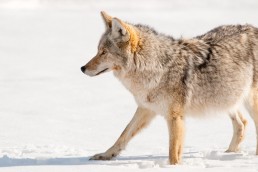Aggressive coyote problems increase in late winter
SHARE THIS POST
WARNING!!!!!
Aggressive coyote problems increase over the next 4-6 weeks as it is mating season for coyotes throughout much of the Midwest. Do not let your dogs out alone and don’t allow your outdoor cats to roam. Although coyotes are prevalent in outlying and rural areas, they’re also thriving in suburban and urban areas, and smaller towns as well.
Coyote breeding typically peaks in late February and early March, the gestation period averages 58 to 63 days. Male coyotes can become more aggressive during this time of year, the long and short of it all is that coyotes always pose a risk to your dog (and other small pets) and even to infants. That risk increases during mating season.
Aggressive coyotes: mating season
Spay or neuter your pet. Coyotes are attracted to and can mate with unspayed or unneutered domestic dogs. Unspayed female dogs in season can attract male coyotes. Un-neutered male dogs can be lured away by the scent of a female coyote in her ovulation cycle.
Additionally, male dogs can be lured by the female coyote’s scent and killed by male coyotes.
You should also be mindful that clever coyotes learn the daily schedules of people and their pets. If you let your dog out every evening at 9 p.m., chances are that a coyote is well aware of your routine. He might be waiting in the shadows at 9 p.m. sharp.
So change your schedule a bit, walk your dog on leash close to you, and keep a close eye on them at all times.
Strategies to keep your pets and infants safe during coyote mating season.
Are you enjoying this post?
You can be among the first to get the latest info on where to go, what to use and how to use it!
Coyote problems: cautions and solutions
* Never feed coyotes — it is illegal to feed coyotes in most places. Feeding endangers your family and neighbors as it lures coyotes into neighborhoods.
* Keep unattended cats and dogs indoors or in completely enclosed runs, especially at night, and do not assume that a fence will keep a coyote out of your back yard.
* Accompany your leashed pet outside. Make sure you turn on lights if it is dark to check your back yard for unexpected wildlife.
* Keep dogs on short leashes while walking outside; the Division of Wildlife recommends a leash no longer than six feet.
* Leave noisemakers on hand to scare away coyotes that may enter your yard, such as whistles and horns.
* Yell, clap hands, blow a whistle and try to make yourself look larger if you have a close encounter with a coyote.
* Do not leave infants or small children unattended.
MWO
MWO
SHARE THIS POST
Did you enjoy this post?
You can be among the first to get the latest info on where to go, what to use and how to use it!
Dave Mull
Dave Mull of Paw Paw, Mich. has spent his career communicating the outdoors experience and runs Inner Viking Media. He enjoys kayak fishing for anything that swims in the lakes and rivers of the Midwest and beyond, and even uses his MirroCraft, from time to time. Available for seminars.


